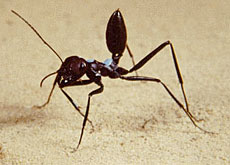Swiss ant researcher wins top science prize

The director of Zurich University's zoology department, Rüdiger Wehner, has been awarded one of the top accolades in Swiss science, the Marcel Benoist prize.
Wehner received a SFr100,000 ($68,000) prize at a ceremony in Bern on Friday for his work on the behaviour of the Cataglyphis ant of the Sahara desert.
The prize is awarded annually for a “discovery or study” that has made an outstanding contribution to Swiss science.
It was founded by a wealthy French lawyer, Marcel Benoist, in 1920 and is the oldest and most prestigious Swiss science prize. Past alumni include several Nobel laureates.
Wehner has been studying the Cataglyphis ant for more than 30 years. His research has shown that they have an inbuilt navigation system, which rivals the high-tech global positioning system (GPS).
They may be tiny, weighing just 10mg, but their ability to find their way back to their nests in a hostile and barren environment is remarkable.
The ants are carrion feeders, foraging for food across hundreds of metres of desert. Their diet usually consists of insects which failed to make it back to their nests before sunrise.
The Sahara desert is difficult to navigate; sand dunes shift constantly and a storm can completely change the terrain. There are also very few points of reference such as trees or vegetation, which animals normally use as navigational aids.
Yet despite the difficulties, the ants return to their nests in a straight line, something called path integration.
Complex task
Wehner was interested in how such a small brain could carry out such a complex task and his research has focused on the ant’s neural pathways or nervous system.
“I wanted to know how an animal copes with a sensory capacity, which humans do not have,” Wehner told swissinfo.
His work showed that the ants’ neural pathways worked in a similar way to those in other “higher” animals such as mammals and primates.
“The building blocks of our nervous system are in many respects very similar to the ones in lower animals,” he explains, adding that we can learn a lot about ourselves by understanding ants’ behaviour.
Robots
As part of his laboratory research in Switzerland, Wehner built a number of robots with the help of Zurich university’s IT department. The robots were fitted with special circuits programmed with information based on the ant’s neural pathways.
“Once you know about the neural circuitry in an ant, you can transfer it on to an electrical circuit and put this in a robot,” he says.
The robots, however, are a lot bigger than the ants weighing 10 kilograms, compared to the ant’s 10mg.
“The robot moves far more clumsily than the speedy ant does, but its compass device works in a similar way,” Wehner elaborates. “But the ant has far more navigational tools in its tool box than our robot. The ant, even though it’s tiny, is far superior.”
Future research
Up until now Wehner’s research has dealt with the ant’s two-dimensional world or how it navigates its way through a flat desert landscape. The future, Wehner says, is 3-D.
“It looks rather funny but in the desert we’ve built a kind of [insect] roller coaster. There are lots of small aluminium channels for the ants to walk uphill and downhill. We can then test how they navigate in a three-dimensional world.”
swissinfo, Sally Mules
Professor Rüdiger Wehner has been studying the Cataglyphis ant of the Sahara for over 30 years.
The ants are one of few creatures to feed in daytime temperatures of up to 53 degrees centigrade.
The ants weigh 10mg.
Professor Rüdiger Wehner trained as a neurophysiologist and behavioural biologist.
Initially he studied the behaviour of bees in desert conditions in North Africa, but the experiments failed so he decided to study the ants he saw scurrying around on the sand.
The Cataglyphis ants are easy to handle and number, and they don’t sting or bite.
The desert field centre in Tunisia is the main research hub for 12 Swiss scientists, along with other researchers from England, Australia and Germany.

In compliance with the JTI standards
More: SWI swissinfo.ch certified by the Journalism Trust Initiative










You can find an overview of ongoing debates with our journalists here . Please join us!
If you want to start a conversation about a topic raised in this article or want to report factual errors, email us at english@swissinfo.ch.